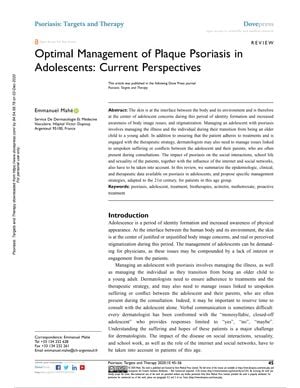Optimal Management of Plaque Psoriasis in Adolescents: Current Perspectives
November 2020
in “
Psoriasis : Targets and Therapy
”

TLDR The document concludes that proper treatment and management of plaque psoriasis in adolescents can improve their quality of life.
The document from November 1, 2020, provides an in-depth analysis of the management of plaque psoriasis in adolescents, highlighting the condition's prevalence of 1.2% to 2.0% in Europe and its psychological and social impacts during a critical period of identity formation. It notes that obesity is a significant comorbidity and that the clinical presentation in adolescents is similar to adults, with scalp and nail involvement being common. The negative impact on quality of life is emphasized, including effects on social interactions, school life, and sexuality. The document suggests screening for arthritis and other comorbidities, and that successful treatment can improve quality of life scores. It also mentions that psoriasis flares can be triggered by stress, trauma, and infections, but not typically by systemic drugs or HIV infection as in adults. The onset of psoriasis in adolescence does not appear to influence the prevalence of cardiovascular and metabolic comorbidities, psoriatic arthritis, or disease severity in adulthood.
The document further discusses the impact of psoriasis on adolescents' sports participation and the importance of physical activity in lowering the risk of psoriasis. It addresses the challenges in discussing sexual health and the need for dermatologists to guide patients to reliable information sources, including the use of teleconsultations. It stresses the importance of education and the need for dermatologists to spend time discussing the condition and treatment options with adolescents. It acknowledges that some treatments are not licensed for use in adolescents but can be prescribed off-label.
Finally, the document outlines treatment strategies, recommending topical steroids for long-term management, topical calcineurin inhibitors for areas prone to atrophy, and dithranol for short-term therapy. It details systemic treatments like methotrexate, acitretin, and cyclosporine, and discusses biologic treatments such as etanercept, adalimumab, ustekinumab, ixekizumab, and secukinumab, highlighting the importance of proactive management. The author, E. Mahé, discloses paid activities with pharmaceutical companies but reports no conflicts of interest for this work. The document underscores the need for further research and standardized approaches to improve management and quality of life for adolescents with plaque psoriasis.




